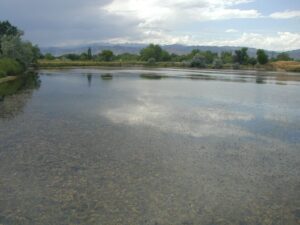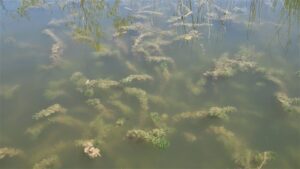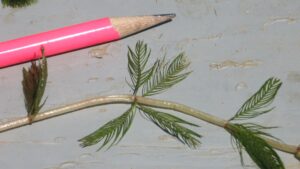Eurasian watermilfoil
Elaeagnus angustifolia
Myriophyllum spicatum
This exotic species is an aquatic submerged plant that is one of the most destructive aquatic weeds known. Eurasian watermilfoil (EWM) has leaves whorled around the stem with 14 or more leaflets on each side. Fruiting stems with small yellow flowers form spikes above the water. EWM is often confused with native milfoils. Native species typically have fewer than 14 (5 to 10) leaflet pairs per leaf. The exotic species can hybridize with the native milfoils. Hybrids may require DNA testing to distinguish from non-hybrids.
EWM aggressively forms dense mats that block the ability of sunlight to enter the water and stop the growth of native species, displaces wildlife habitat, and impede all forms of water-based recreation. After fruiting, EWM makes fragments of the plant, these fragments are responsible for new colonies as they float to other areas, sink, and start new plants. Transport on boating equipment is a significant means of plant establishment in new bodies of water. Any equipment used on or in the water can collect and spread this aquatic species.
This aggressive invader establishes in moving and standing waters and grows at a rate of approximately one foot per week. It can infest an entire lake within a couple of years after introduction, EWM has less value as a food source for waterfowl than the native plants that it replaces.
Remember to always clean, drain, and dry your boats, trailer, gear, and any equipment when playing or working in aquatic systems. It is not legal to transport watercraft over land with water drain plugs or aquatic vegetation on board per Colorado Parks and Wildlife (CPW) Aquatic Nuisance Species (ANS) regulations.
According to CPW, this is the highest priority aquatic noxious weed in Colorado. Millions of dollars are spent nationwide for control efforts. If you detect EWM or any other ANS, please report it to Invasive.Species@state.co.us. The CPW ANS Program will verify the detection per regulation and will collaborate with CDA, the County, and other pertinent landowners or stakeholders to determine and implement the appropriate management response.
RESOURCES
U.S. Geological Survey, Nonindigenous Aquatic Species Database
https://www.dnr.state.mn.us/invasives/aquaticplants/milfoil/index.html





